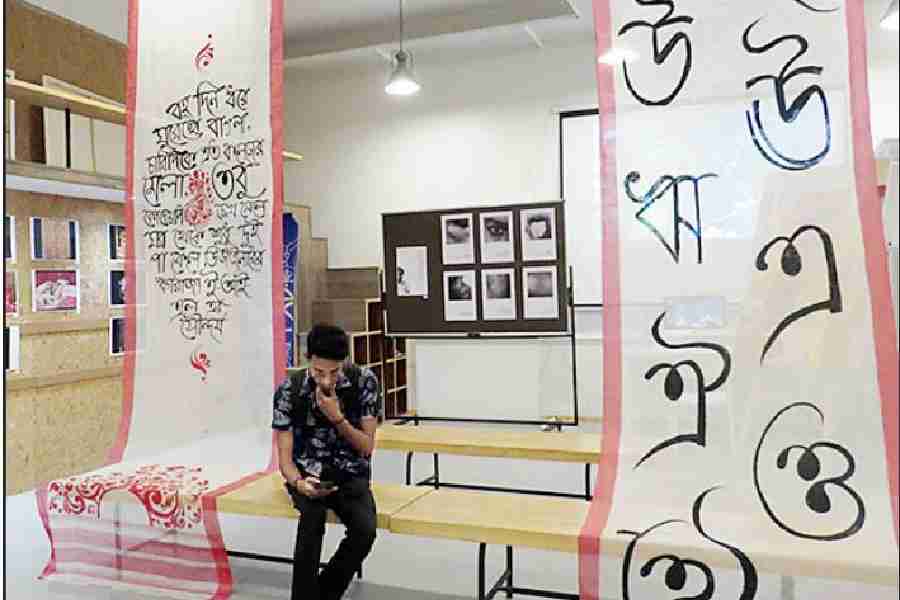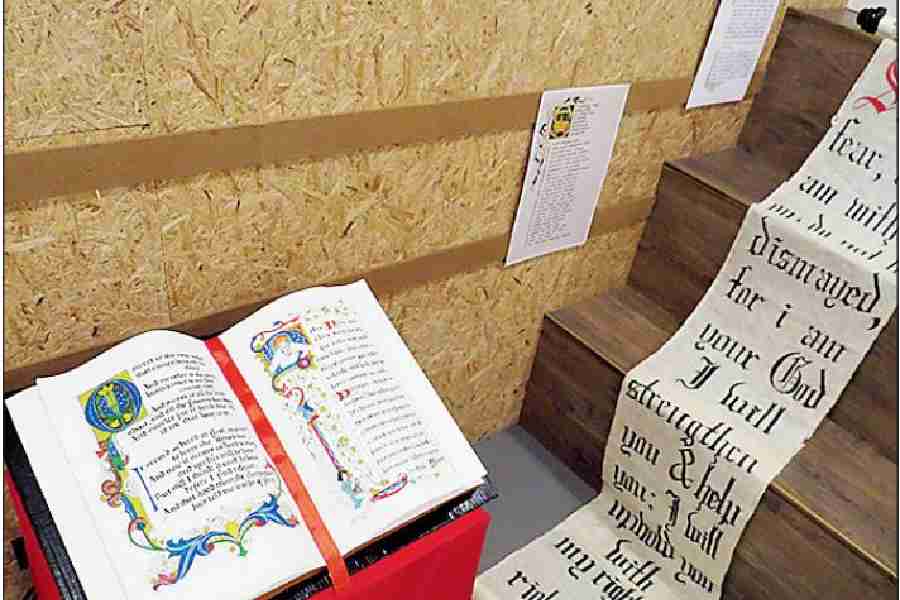Fonts as exhibits: Techno India’s design school organises fest to celebrate typefaces


Fonts held centrestage at the Kolkata Design Fest at Techno India University. The fest was the annual exhibition of Ecole Intuit Lab, a design school headquartered in Paris which is collaborating with the Sector V university.
The theme of the 2023 edition was typograph. Each exhibition hall was dedicated to a typeface, assigned to a particular batch. First year student Pritha Prokhorova was leading the team in the hall dedicated to Cyrillic, which is used in Slavic languages like Russian, Bulgarian, Serbian, Ukrainian and Belarusian. “I have taken some letters from old Church Slavonic script and a few from Glagolitic script as well,” said the girl whose father is Russian.
Some letters in these scripts were painted in large font sizes on jute cloth and the pieces were stuck on two 20ft strips of muslin cloth. The drapes were hung from the ceiling and parted in a way to reveal a book open at the first page of a Slavic folklore. Cheburashka, a 1971 animation film, was playing on a screen. “It features talking animals coexisting with humans. My father’s generation grew up watching the film,” she said. The second years had to tackle Oriental types, used in Chinese, Japanese and Korean. “We are taking a minimalistic approach that is so typical of the country,” said Rhitam Majumdar, a second year student, busy decorating a faux cherry blossom tree. There were also a sake bar with lanterns hanging from the ceiling.
The third year students had Indian types as their theme. There was a lot of Bengali in the room, including on two hanging drapes. “Fonts are not the stars of our show but background elements supporting the world we have created,” said Avijoy Biswas, a student from CD Block.

The world created included nods to lal paar sada sari, tea stall and truck face typography. “The truck writing styles are typical of India,” he added. Urdu script had also been used in places as the students “wanted to encapsulate the secular identity of India”. An advertisement caught the eye, in which a boy with a rose in hand grimaces as the girl lying next to him is turning away, busy munching on a branded chocolate bar. “Modeling, photography and art direction — everything is by us in these ads. The boy, Aronyo Guha of second year, was asked to think of the saddest moments of his life, and he nailed the expression,” Avijoy smiled.
The post-graduate students dealt with the Latin script. They started in the Medieval era, putting up impressions of bolts and knockers on the wooden door. There were swords, shields and lanterns on display to represent the age. A representation of a Gutenberg Bible, the first book printed in Latin using mass-produced movable metal type in Europe, was placed next to a printing block. There were also masks used in masquerade balls of the era, which were kept as props for visitors to pose with for pictures. “We did not want to get too much into history. Since the French script is part of the Latin script family, we have imagined this space to be modern-day Marseilles with graffiti and created a Parisian cafe with tables placed outdoors,” said Lawanda War, who hails from Shillong.

The Game Art & Design students had a 24-hour hackathon in February that had split them into teams. “They were asked to visualise a world where a fascist leader had taken over. They had to name the government, create its visual identity and build characters. They used AI (Artificial Intelligence) models using the same brief and juxtaposed them with manual creations. They were also asked to visualise pharmacy products,” said Ishan Roy, head of academics.
There were also some high-tech exhibits using augmented reality. Manoshi Roychowdhury, cochairperson of the Techno India Group, pointed out that response in the four-year Bachelor of Design degree had picked up since last year. “Our curriculum has been designed by Ecole Intuit Lab in France. This is their second footprint in India, after Mumbai. But we, being a university, can give a degree.” The undergraduate courses, she added, offered specialisations in visual communication and digital design, digital product design and game art and design. There were post-graduate courses too.